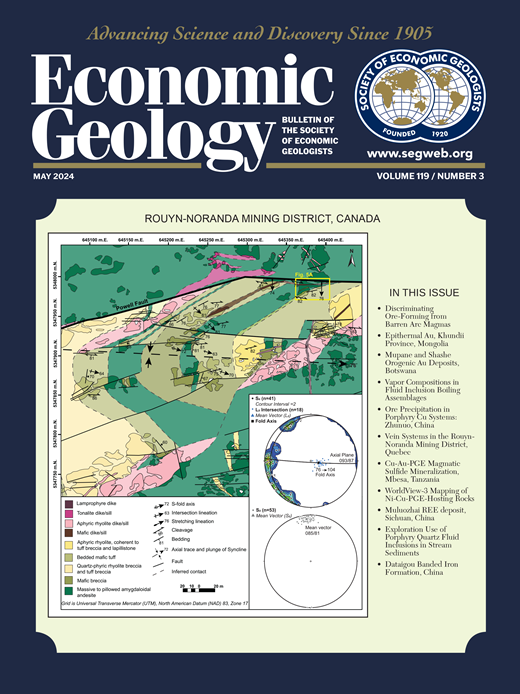华南江南造山带中部团山北造山带金矿床的叠加金矿化事件
IF 4.9
1区 地球科学
Q1 GEOCHEMISTRY & GEOPHYSICS
引用次数: 0
摘要
摘要江南造山带是中国最大的金矿产区之一,经历了多期岩浆作用、变形作用、变质作用和造山带金矿化的构造叠印复杂的造山活动。在新元古代、中古生代、三叠纪和早白垩世发现了不同的造山事件,反映了碰撞和陆内造山事件。然而,由于缺乏合适的定年矿物,对江南造山带金的沉积时代的限定很差。造山带野外研究表明,团山北金矿床发育2代含金石英-铁云母-黄铁矿-毒砂脉(Q2和Q3),其中后2代含铁云母和贱金属硫化物较多。Q2脉体形成于与D1变形相关的近南北向缩短,以及由此产生的亚水平至低倾角EW-至wnw向的逆压断层。Q3矿脉主要分布在中~陡倾nw向张/张剪切断裂和中倾NE ~ nne向逆压断裂中,是D2变形过程中nw - se向缩短的产物,约占总金矿量的70%。这两代矿脉在时间上都比团山北花岗闪长岩寄主(437.2±4.2 Ma)年轻,均被约225 Ma的辉绿岩脉截断。在Q2和Q3矿脉中,热液独居石与原生金及含金金属硫化物共存。Q2独居石的Tera-Wasserburg下截距年龄为415.1±2.1 Ma,与铁白云石Sm-Nd等时年龄410±15 Ma和激光烧蚀-电感耦合等离子质谱热液锆石206Pb/238U年龄411.2±4.0 Ma的误差一致。Q3独居石的Tera-Wasserburg低截距年龄为234.3±1.1 Ma。这些新时代表明,早泥盆世的黄金事件在大约200万年后被沿着同一构造体系的热液活动覆盖,因此黄金资源必须是两个时间上不同的事件的产物。地质和构造证据,加上现有已发表的地球化学数据,表明这两个成矿事件都与大多数造山带金矿床的典型地壳变质作用有关。流体来源于新元古代变质沉积基底岩,极有可能来自新元古代苍溪岩群绿片岩-角闪岩相变质脱挥发作用。没有证据表明任何类型的岩浆对这两个时期的成矿过程有贡献。这些数据最好的解释是,基底的不同部分在不同时期在绿片岩-角闪岩边界附近变质,但在这两个时期,含金变质流体最终迁移到相同的构造导管中。本文章由计算机程序翻译,如有差异,请以英文原文为准。
Superimposed Gold Mineralization Events in the Tuanshanbei Orogenic Gold Deposit, Central Jiangnan Orogen, South China
Abstract The Jiangnan orogen, one of the largest gold-producing areas in China, has experienced multiple orogenic events with complex structural overprinting that is marked by multiple stages of magmatism, deformation, metamorphism, and orogenic gold mineralization. Different orogenic events have been recognized in the Neoproterozoic, mid-Paleozoic, Triassic, and Early Cretaceous, reflecting collisions and intracontinental orogenic episodes. The age of gold deposition in the Jiangnan orogen, however, has been poorly constrained owing to the absence of suitable dating minerals. Field studies in the orogen indicate the Tuanshanbei gold deposit includes two generations of auriferous quartz-ankerite-pyrite-arsenopyrite veins (Q2 and Q3), with the latter of the two notable for containing more abundant ankerite and base metal sulfides. The Q2 veins were formed throughout the near S-N–directed shortening associated with D1 deformation and along resulting subhorizontal to low-angle-dipping EW- to WNW-striking transpressive faults. The Q3 veins, containing about 70% of the total gold resource, were primarily localized in moderately to steeply dipping NW-striking tensional/tensional shear faults and moderately dipping NE- to NNE-striking transpressive faults that were products of NW-SE–directed shortening during D2 deformation. Both vein generations are temporally younger than the 437.2 ± 4.2 Ma Tuanshanbei granodiorite host, and both are crosscut by postgold ca. 225 Ma diabase dikes. Hydrothermal monazite coexists with native gold and gold-bearing metal sulfides in the Q2 and Q3 veins. The Q2 monazite yielded a Tera-Wasserburg lower intercept age of 415.1 ± 2.1 Ma, consistent within error with an ankerite Sm-Nd isochron age of 410 ± 15 Ma and a laser ablation-inductively coupled plasma-mass spectrometry hydrothermal zircon 206Pb/238U age of 411.2 ± 4.0 Ma. The Q3 monazite yielded a Tera-Wasserburg lower intercept age of 234.3 ± 1.1 Ma. These new ages suggest that the Early Devonian gold event was overprinted by hydrothermal activity along the same structural system almost 200 m.y. later such that the gold resource must be a product of two temporally distinct events. Geologic and structural evidence, coupled with existing published geochemical data, suggests both ore-forming events were related to crustal metamorphism typical of most orogenic gold deposits. Fluids would have been derived from Neoproterozoic metasedimentary basement rocks, most likely from metamorphic devolatilization of the Neoproterozoic Cangxiyan Group greenschist-amphibolite facies metasediments. There is no evidence suggesting any type of magmatic contribution to the ore-forming process at either time. The data are best interpreted to suggest that various parts of the basement were metamorphosed near the greenschist-amphibolite boundary at different times, but during both times, the gold-bearing metamorphic fluids eventually migrated into the same structural conduits.
求助全文
通过发布文献求助,成功后即可免费获取论文全文。
去求助
来源期刊

Economic Geology
地学-地球化学与地球物理
CiteScore
10.00
自引率
6.90%
发文量
120
审稿时长
6 months
期刊介绍:
The journal, now published semi-quarterly, was first published in 1905 by the Economic Geology Publishing Company (PUBCO), a not-for-profit company established for the purpose of publishing a periodical devoted to economic geology. On the founding of SEG in 1920, a cooperative arrangement between PUBCO and SEG made the journal the official organ of the Society, and PUBCO agreed to carry the Society''s name on the front cover under the heading "Bulletin of the Society of Economic Geologists". PUBCO and SEG continued to operate as cooperating but separate entities until 2001, when the Board of Directors of PUBCO and the Council of SEG, by unanimous consent, approved a formal agreement of merger. The former activities of the PUBCO Board of Directors are now carried out by a Publications Board, a new self-governing unit within SEG.
 求助内容:
求助内容: 应助结果提醒方式:
应助结果提醒方式:


